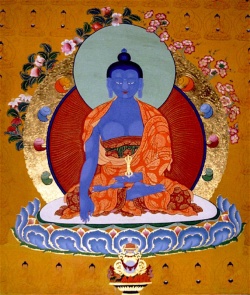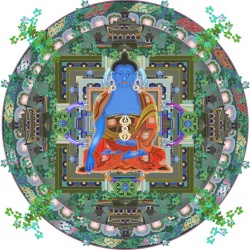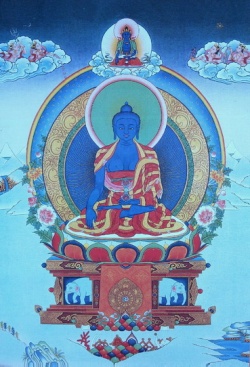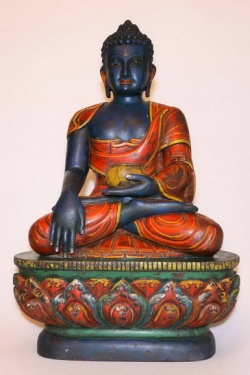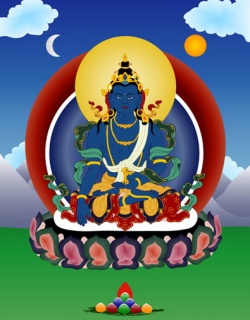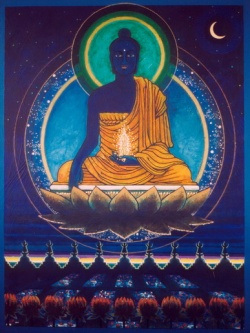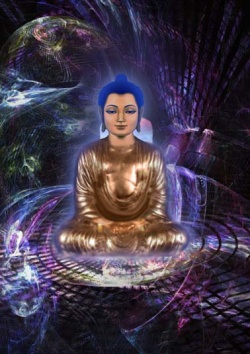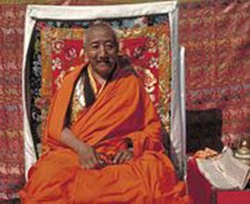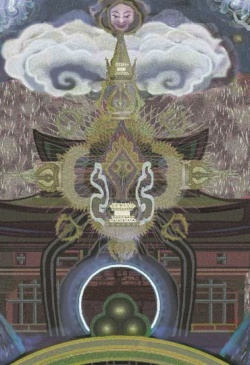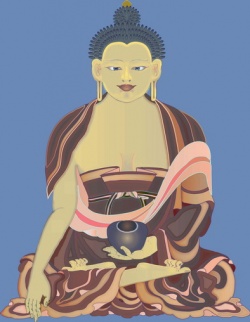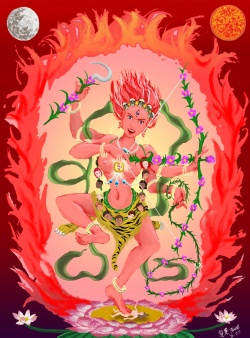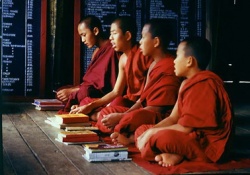Akshobhya
<poem>
Akshobhya in other languages:
Akshobhya (Skt. akṣobhya; Tib. མི་བསྐྱོད་པ་, Mikyöpa, Wyl. mi bskyod pa; Eng. 'The Unshakeable') — one of the buddhas of the five families.
He is the Buddha of the vajra family, and is usually depicted as blue in colour and holding a vajra.
Source
In Vajrayana Buddhism, Akshobhya (Sanskrit: अक्षोभ्य, Akṣobhya, "Immovable One"; simplified Chinese: 阿閦如来; pinyin: Āchùrúlái; Japanese:阿閦如来) is one of the Five Wisdom Buddhas, a product of the Adibuddha, who represents Consciousness as an aspect of reality.
By convention he is located in the east of the Diamond Realm and is the Lord of the Eastern Pure land Abhirati ('The Joyous'), although the Pure land of Akshobhya's western counterpart Amitābha is far better known.
His consort is Lochanā and he is normally accompanied by two Elephants.
His color is blue and his attributes include the Bell, three robes, and staff, along with a jewel, Lotus, prayer Wheel, and sword. He has several emanations.
Origin
Akshobhya appears in the "Scripture of The Buddha-land of Akshobhya" (Chinese: 阿閦佛國経; pinyin: Āchùfó Guó Jīng), which dates from 147 AD and is the oldest known Pure land text.
According to the scripture, a Monk wished to practice the Dharma in the eastern World of delight and made a vow to think no Anger or malice towards any being until Enlightenment.
He duly proved "immovable" and when he succeeded, he became The Buddha Akshobhya.
Akshobhya is sometimes merged with Acala (jap. 不動明王 Fudō-myōō?), whose name also means 'immovable one' in Sanskrit.
However, Acala is not a Buddha, but one of the [[Five Wisdom Kings of the Womb Realm in Vajrayana.
Prior to the advent of Bhaisajyaguru (jap. Yakushi Nyorai), Akshobhya was the subject of a minor cult in Japan as a Healing Buddha, though even now both are found within the Shingon school of Buddhism in Japan.
Recently, newly discovered Gāndhārī texts from Pakistan in the Bajaur Collection have been found to contain fragments of an early Mahāyāna Sutra mentioning Akshobhya.
Preliminary dating through palaeography suggests a late 1st century to early 2nd century AD provenance.
More conclusive radiocarbon dating is under way. A preliminary report on these texts has been issued by Dr Ingo Strauch, with a forthcoming paper on Akshobhya texts expected soon.
Iconography
Akshobhya is the embodiment of 'mirror Knowledge' (Sanskrit: ādarśa-jñāna; refer Panchajnana). A Knowledge of what is real, and what is Illusion, or a mere reflection of actual reality.
The mirror is Mind itself - clear like the sky, empty yet luminous.
Holding all the images of space and time, yet untouched by them. He represents the eternal Mind, and the Vajra family is connected with reason and intellect.
Its brilliance illuminates the darkness of Ignorance, its sharpness cuts through confusion.
The Vajra family, to which Akshobhya belongs, is associated with the element of water.
This is why the two colors of Vajra are blue or white. Bright white like sun reflecting off water, and blue, like the depths of the ocean.
Even if the surface of the ocean is blown into crashing waves, the depths remain undisturbed, imperturbable.
And though water may seem ethereal and weightless, in Truth it is extremely heavy. Water flows into the lowest place and settles there.
It carves through solid rock, but calmly, without violence. When frozen, it is hard, sharp, and clear like the intellect, but to reach its full potential, it must also be fluid and adaptable like a flowing river.
These are all the essential qualities of Akshobhya.
Many wrathful tantric beings are represented as blue in colour because they embody the transmuted energy of hatred and aggression, into Wisdom and Enlightenment.
Source
Akshobhya Buddha (Bu-dong Fo): The eastern Immutable, Immoveable, or Imperturbable Buddha with mirror-like wisdom. Usually shown as being deep blue, but in certain higher tantras, He is white.
One of the Five Transcendent Buddhas. Appears in His wrathful form as Hevajra Buddha.
Akshobhya (S): Tibetan: Mi-kyö-pa. "Unshakeable One." Lord of the Vajra Family, one of the Five Dhyani Buddhas, or heads of the Five Buddha Families, representing the fully purified Skandha, or Aggregates of Form.
In the Natural Liberation, he represents the Wisdom-mirror and the transmutation of the poison of aggression and hatred. Akshobhya is blue, and is associated with the east and the ground - Abhirati Buddha.
He originates from the blue seed syllable HUM and represents the Vajra family; immutable and imperturbable.
The Path to Enlightenment through the Vajra family is one of breaking free of constraints and obstacles, transmuting negativity, and is generally more dynamic and proactive.
He makes the Earth touching Mudra (S. bhumisparsa) with the tip of the middle finger touching the Earth with palm drawn inwardly, while his left hand rests on his lap face .
He faces the East and, is often depicted with his consort Lochana, She of the Buddha eye, who expresses the mirror-like primordial Wisdom.
Akshobhya
阿k仏 (Skt; Jpn Ashuku-butsu)
A Buddha said to be lord of the Land of Joy (Skt Abhirati) located in the east.
Akshobhya means immovable; hence this Buddha is also known by the name Immovable.
According to the Land of Akshobhya Buddha Sutra, Akshobhya Buddha carried out his bodhisattva practice under the Buddha Large Eyes and attained enlightenment, completely freeing himself from all animosity and earthly desires, and now preaches in the Land of Joy.
According to the "Parable of the Phantom City" (seventh) chapter of the Lotus Sutra, Wisdom Accumulated, the first of the sixteen sons of Great Universal Wisdom Excellence Buddha, following his father, practiced the Lotus Sutra and attained enlightenment as Akshobhya Buddha.
The Nirvana Sutra describes King Possessor of Virtue and the monk Realization of Virtue as having been born together in the land of Akshobhya Buddha. Akshobhya Buddha, who is said to dwell in the east, appears in many Mahayana sutras along with Amida Buddha of the west.
Akṣobhya. (T. Mi bskyod pa; C. Achu fo; J. Ashuku butsu; K. Ach’ok pul 阿閦佛).
In Sanskrit, “Immovable” or “Imperturbable”; the name given to the buddha of the East because he is imperturbable in following his vow to proceed to buddhahood, particularly through mastering the practice of morality (Śīla).
Akṣobhya is one of the Pañcatathāgata (five tathāgatas), the buddha of the vajra family (Vajrakula).
There are references to Akṣobhya in the Prajñāpāramitā sūtras and the Saddharmapuṇḍarīkasūtra (“Lotus Sūtra”), suggesting that his cult dates back to the first or second century of the Common Era, and that he was popular in India and Java as well as in the Himālayan regions.
The cult of Akṣobhya may have been the first to emerge after the cult of Śākyamuni, and before that of Amitābha.
In the Saddharmapuṇḍarīkasūtra, Akṣobhya is listed as the first son of the Buddha Mahābhijñā Jñānābhibhu, and his bodhisattva name is given as Jñānākara.
His cult entered China during the Han dynasty, and an early text on his worship, the Akṣobhyatathāgatasyavyūha, was translated into Chinese during the second half of the second century.
Although his cult was subsequently introduced into Japan, he never became as popular in East Asia as the buddhas Amitābha or Vairocana, and images of Akṣobhya are largely confined to Maṇḍalas and other depictions of the pañcatathāgata.
Furthermore, because Akṣobhya’s buddha-field (Buddhakṣetra) or Pure Land of Abhirati is located in the East, he is sometimes replaced in maṇḍalas by Bhaiṣajyaguru, who also resides in that same direction.
Akṣobhya’s most common Mudrā is the Bhūmisparśamudrā, and he often holds a Vajra. His consort is either Māmakī or Locanā.
Akshobhya, The Mirror to Our Souls (Tib. Mikyopa): One of The Five Meditating Buddhas According to the Tibetan Dhammapada:
Those who control their wrath when it rears up As they would a horse when it strays loose, I call the best trainers, those who do not, are common beings.
Akshobhya is believed to transform the human failing of anger into a clear mirror like wisdom. (mirror like wisdom)
With this wisdom, we see things just as they are, impartially and unaffectedly.
Indeed, whether it be a red rose or a bloody dagger, a mirror will reflect both just as they are. It will not be judgmental and distinguish between the two reds, attempting to hold to the first and flee from the second.
No reflection in a mirror sticks to it, and none repels it. The mirror always stands imperturbable and immutable, just as we should, whether the circumstances be favorable or unfavorable to us.
Akshobhyas blue color is closely linked to the mirror symbolism.
Blue is the color of water, and water has the capacity to act as a clear mirror. He makes the Bhumisparsha mudra (earth touching gesture).
This gesture recalls the incident just before Buddha s enlightenment when he was challenged by Mara, the personification of evil.
Mara was convinced that the spiritual throne where Buddha was sitting belonged rightly to him.
Accordingly he challenged Buddha to prove his claim to the seat.
Buddha moved his hand to touch the ground with his fingertips, and thus bid the goddess Earth to bear witness to his right to be sitting where he was.
She did so with a hundred thousand roars, and validated Buddha s assertion.
More relevant to our interest here is the fact that this gesture suggests confidence, deep rootedness, and the same kind of determination which carried the Buddha to his enlightenment, inspite of the numerous hurdles which crossed his path.
Akshobhyas emblem is the vajra. The Vajra is the quintessential symbol of Vajrayana Buddhism, which derives its name from the vajra itself.
The Sanskrit term vajra means the hard or mighty one, and its Tibetan equivalent dorje means an indestructible hardness and brilliance like the diamond, which cannot be cut or broken.
The vajra essentially signifies the immovable, immutable, indivisible, and indestructible state of enlightenment.
Thus is Akshobhya touching the earth with the fingertips of his right hand, the earth too being a symbol of the immutable, the solid, and the concrete.
Akshobhyas mount is the elephant.
An elephant places its foot upon the earth with unshakeable certainty.
It has the same unalterable quality as the Buddha s fingers touching the ground, and the same determination that carried Buddha through his tribulations.
Akshobhya is considered the ruler over the eastern direction.
It is the direction where dawn takes place.
Indeed, Buddha s victory over Mara heralded the dawning of a new, spiritual reality.
The manifestation of the aggregate of consciousness of all Buddhas. He has a blue coloured body.
In Vajrayana Buddhism, Akshobhya (Sanskrit for "Immovable One") (Japanese for Ashuku nyorai; Chinese achurulai; Mongolian for Kodelusi ugei) is one of the Five Wisdom Buddhas, a product of the Adibuddha, who represents consciousness as an aspect of reality.
By convention he is located in the east of the Diamond Realm and is the lord of the Eastern Pure Land Abhirati (The Joyous), although the Pure Land of Akshobhyas western counterpart Amitabha is far better known.
His consort is Locana and he is normally accompanied by two elephants.
His color is blue and his attributes include the bell, three robes, and staff, along with a jewel, lotus, prayer wheel, and sword. He has several emanations.
Akshobhya appears in the "Scripture of the Buddha land of Akshobhya" (achufo guo jing), which dates from 147 AD and is the oldest known Pure Land text.
According to the scripture, a monk wished to practice the Dharma in the eastern world of delight and made a vow to think no anger or malice towards any being until enlightenment.
He duly proved "immovable" and when he succeeded, he became the buddha Akshobhya.
Akshobhya is sometimes merged with Acala (Japanese: Fudo myo o), whose name also means immovable one in Sanskrit.
However, Acala is not a buddha, but one of the Five Wisdom Kings of the Womb Realm in Vajrayana.
Prior to the advent of Bhaisajyaguru (Yakushi), Akshobhya was the subject of a minor cult in Japan as a healing buddha, though even now both are found within the Shingon school of Buddhism in Japan.
Recently, newly discovered Gandhari texts from Pakistan in the Bajaur Collection has been found to contain fragments of an early Mahayana sutra mentioning Aksobhya.
Preliminary dating through paleography suggests a late first century to early second century AD provenance. More conclusive radiocarbon dating is underway.
A complete analysis and report of the text is expected in late 2008.
Earliest of the non historical celestial Buddhas who is believed to govern the Eastern Paradise also known as the Abhirati. He is mostly represented in dark blue or sometimes even golden colour.
He has a vajra or a diamond sceptre in his right hand and makes the earth touching gesture from his left. He is usually shown seated on a blue elephant. Aksobhya is well known in Nepal and Tibet.
East, blue, vajra family (diamond family) , aggression and mirrorlike wisdom.
One of the 5 Transcendent Buddhas;
Source
Articles containing word "Akshobhya" in title
- 12. Vision of the Universe Abhirati and the Tathagata Aksobhya
- Akshobhya's
- Akshobhya, Akṣobhya: 14 definitions - Wisdom Library
- Akshobhya, the Immutable
- Akshobhya-Buddha
- Akshobhya "Immovable One"
- Akshobhya (Second Dhyani-Buddha)
- Akshobhya - Buddha with Mirror-like Wisdom
- Akshobhya Buddha
- Akshobhya Buddha?
- Akshobhya Buddha Dharani
- Akshobhya Buddha Prayer
- Akshobhya Buddha and the Kagyu Lineage
- Akshobhya Buddha is one of the five Dhyani Buddhas
- Akshobhya Buddha mantra
- Akshobhya Empowerment to Complete Teachings for Russian Buddhists
- Akshobhya Fire Puja 2018
- Akshobhya Mantra - Tibetan Buddhism Mantra - Buddhist Meditation
- Akshobhya Practice
- Akshobhya Vajra
- Akshobhya family
- Akshobhya is one of the heavenly Buddhas
- Akshobhya is the second of the Transcendental Buddhas
- Akshobhya puja
- Akshobhya the Undisturbed – Paradigm of Patience
- Akshobhya – Wikipedia
- Akshobhya [阿閦仏] (; Ashuku-butsu):
- Akshobhyas
- Akshobhyavajra
- Akshobhyavajra Guhyasamaja
- Akshobhyavajra Guhyasamaja Meditation Practice Manual
- Akshobhya’s
- Aksobhya
- Aksobhya's
- Aksobhya's Doctrine
- Aksobhya's Iconography
- Aksobhya's Origin
- Aksobhya Buddha
- Aksobhya Mantra
- Aksobhya mantra
- Aksobhyavajra
- Aksobhyavyuha
- Buddha-land of Akshobhya
- Buddha Akshobhya
- Buddha Akshobhya (Tib: Mitrugpa)
- Buddha Akshobhya Buddha Jangchok Puja is especially beneficial for
- Buddha Akshobhya in Mongolia
- Buddha Akshobhya’s Dharani
- Buddha Aksobhya
- Consort of Akshobhya
- Emanation of Akshobhya
- Emanation of the buddha Aksobhya
- Guhyasamaja Akshobhyavajra
- Guhyasamaja Akshobhyavajra's
- Guhyasamaja Akshobhyavajra Meditation (Video)
- Guhyasamja Akshobhyavajra
- In front of her topknot sits the deep-blue Buddha Aksobhya
- Land of Akshobhya Buddha Sutra
- Land of the Buddha Akshobhya
- Mandala of Akshobhya Buddha
- Mandala with Symbols of Guhyasamaja Akshobhyavajra
- Mantra of Akshobhya
- Mirrors of the Heart-Mind - Guhyasamaja Akshobhyavajra Essay
- Nine Deity Akshobhya Mandala
- Nine Deity Vajra Akshobhya Mandala
- Om Akshobhya Hum!
- Pure Land of Akshobhyas
- Pure land of Akshobhya
- Sacred Words of Akshobhya
- Sacred Words of Lord Akshobhya: A Commentary to the Two Stages of the Guhysamaja - Sadhana
- Sacred Words of Lord Akshobhya: A Commentary to the Two Stages of the Guhysamaja Tantra by Aku Sherab Gyatso
- Sadhana of Buddha Akshobhya
- Scripture of the Buddha-land of Akshobhya
- Scripture of the Buddha land of Akshobhya
- Shakti of Aksobhya
- Some Aspects of the Cult of Aksobhya in Mahayana Scriptures
- Spiritual son of Akshobhya
- The Akshobhya Fire Puja 2019
- The Buddha-land of Akshobhya
- The Complete Rite for the Sadhana and Mandala of Bhagavan Vajra Akshobhya (Mitrugpa): Opening the Door to the Pure Land of Superior Delight. English Translations.
- The Five Dhyani Buddhas: Akshobhya Buddha
- The Five Wisdom Buddhas - Akshobhya
- The Grand Buddha Akshobhya Jangchok Puja
- The Pureland Abhirati of Tathagata Aksobhya
- The Realm of Aksobhya: A Missing Piece in the History of Pure Land Buddhism
- The Realm of Aksobhya: A Missing Piece in the History of Pure Land Buddhism,,,,,,,,,9
- The Sadhana Of Buddha Akshobhya
- Vajra Akshobhya
- Vision of the Universe Abhirati and the Tathagata Aksobhya
- Why Akshobhya Buddha
- Why Practice Akshobhya? Karmapa Shares Thoughts Before Empowerment
- Wrathful form of Akshobhya Buddha
- Wrathful manifestation of Akshobhya
